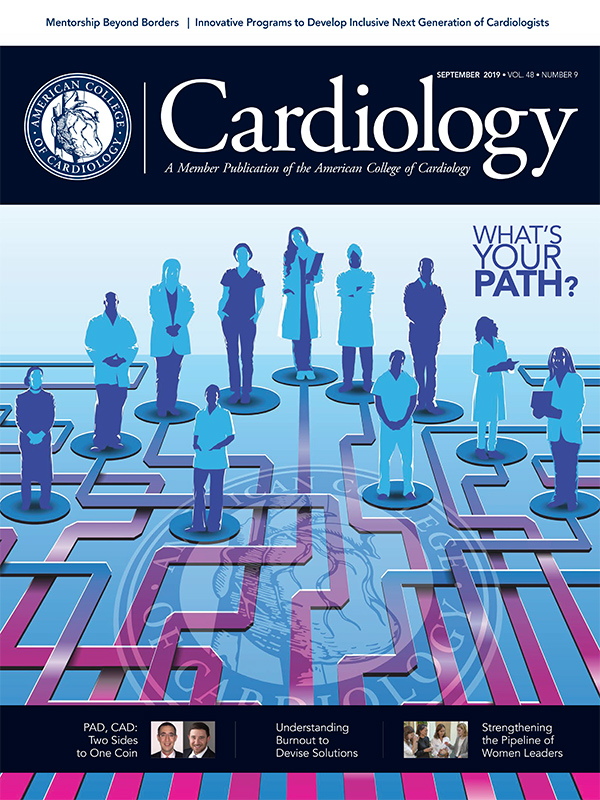Feature | ESC Congress 2019: Top Interventional Takeaways

This year's ESC Congress 2019 in Paris had plenty of late-breaking science and updates for interventional cardiologists. Here are my takeaways that'll affect my practice right away and likely your practice too.
Revascularization: COMPLETE and SYNTAX
Findings from the COMPLETE study are a new milestone in the management of STEMI patients with multivessel coronary artery disease (CAD). After three years of follow-up, complete revascularization was superior to culprit-only PCI with lower cardiovascular death, myocardial infarction (MI) or ischemia-driven revascularization.
This outcome was the same if PCI was performed during or after the index hospitalization. The findings of this study give interventional cardiologists more guidance on how to manage these patients and I'm sure it will change the current STEMI guidelines that focus on culprit-only revascularization.
Staying with revascularization, SYNTAX is another trial that is important to mention. As a reminder, the goal of this trial was to compare the relative efficacy of CABG vs. drug-eluting stent (DES)-PCI (using TAXUS stents) in all-comers with severe three-vessel disease or left main (LM) disease, who were deemed eligible for either CABG or PCI.
At the 10-year follow-up, CABG using one or more arterial grafts was superior to PCI using TAXUS DES, and this was particularly seen for reducing the 12-month rate of major adverse cardiovascular and cerebrovascular events; this was predominantly driven by the need for repeat revascularization in the PCI arm. The largest benefit from CABG seems to be in patients with diabetes.
However, patients with only LM disease who do not have diabetes may do as well with both CABG and PCI. Whether newer-generation DES (everolimus-eluting stents) instead of first-generation (paclitaxel-eluting stents) would be associated with better outcomes compared with CABG remains unknown.
Antiplatelet Therapy: ISAR-REACT 5, THEMIS-PCI, More
The ISAR-REACT 5 trial showed that prasugrel significantly lowered rates of ischemic events vs. ticagrelor for patients with acute coronary syndrome (STEMI or NSTEMI) with no difference in bleeding. At the one-year follow-up, the rates of stroke, MI or death were higher in the ticagrelor group (9.3 percent) compared with the prasugrel group (6.9 percent). The results are surprising and might influence the way we practice. However, it's worth noting the study was conducted mainly in Germany and Italy and the majority of follow-up was by phone.
After more than 3.3 years of follow-up, the THEMIS-PCI trial showed that in patients with diabetes, stable CAD and previous PCI, ticagrelor added to aspirin reduced cardiovascular death, MI and stroke, although with increased major bleeding when compared with aspirin alone. However, there was no difference in fatal or intracranial bleeding. The net clinical benefit was improved with ticagrelor vs. aspirin alone (9.3 percent vs. 11.0 percent), despite the increased major bleeding in patients with vs. without a prior PCI.
The THEMIS trial also showed more bleeding in patients with stable CAD and diabetes without a history of MI or stroke. In this trial, those who received ticagrelor plus aspirin had a lower incidence of ischemic cardiovascular events but with almost a twofold increase in the risk of TIMI major bleeding and higher intracranial hemorrhage.
Putting these two trials together, although the increased bleeding with a potent P2Y12 inhibitor was no surprise, patient selection is key and long-term therapy with ticagrelor in addition to aspirin should be considered in patients with diabetes and a history of PCI who have tolerated antiplatelet therapy with high ischemic risk and low bleeding risk.
Bleeding often is the main reason for premature interruption of P2Y12 inhibitors, especially in elderly patients which increases their thrombotic risk. Furthermore, elderly patients are underrepresented in ACS clinical trials. Indeed, TRITON-TIMI 38 (prasugrel) and PLATO (ticagrelor) had only a small cohort of elderly patients (13 percent and 15 percent, respectively).
However, registry data suggests that >35 percent of patients presenting with NSTEMI are >–75 years old. This lead the investigators of the POPular AGE trial to look into the safety and efficacy of clopidogrel compared with ticagrelor or prasugrel in patients >–70 years old presenting with NSTEMI. At 12 months follow-up, the clopidogrel group had less PLATO major/minor bleeding and less fatal bleeding compared with the ticagrelor or prasugrel group.
In terms of net clinical benefit assessing ischemic and bleeding outcomes, clopidogrel just missed the statistical threshold for noninferority against the other potent P2Y12 inhibitors with similar ischemic outcomes. I'm delighted to see we have more options for elderly patients presenting with ACS and long-term use of clopidogrel appears to be reasonable.
Antiplatelet Therapy and AFib
After two years of follow-up of atrial fibrillation (AFib) patients who were 12 months post PCI or CABG, the primary outcome of all-cause mortality, MI, stroke, unstable angina requiring revascularization or systemic embolism was significantly lower in the rivaroxaban monotherapy group compared with the rivaroxaban/antiplatelet therapy group (4.1 percent vs. 5.8 percent) in the AFIRE trial.
This trial supports monotherapy with novel oral anticoagulants without antiplatelet therapy, which can be considered both safe and effective in the long-term management of patients with AFib and stable CAD.
Aggressive LDL-C Lowering in ACS
At eight weeks, the EVOPACS trial showed that the PCSK9 antibody evolocumab with high-intensity statin therapy was well tolerated and able to substantially reduce LDL-C levels to less than 70 mg/dL in the very high-risk acute coronary syndrome (ACS) patients compared with high-intensity statin and placebo. Also, the adverse events between the two groups were not different.
Although a dedicated cardiovascular outcomes trial is needed to assess the clinical impact of early LDL lowering with evolocumab in the acute setting of ACS, this trial is one step forward for assessing the impact of evolocumab in ACS compared with stable CAD patients.
Structural Heart Disease
I'd like to close with an important aortic valve stenosis (AS) study. Using the large National Echocardiographic Database of Australia registry, any AS was found to be associated with an adverse prognosis. Mortality was substantially increased among patients with severe AS. However, moderate (mean gradient 20.0 to 39.0 mm Hg/peak velocity 3.0 to 3.9 m/s) AS was also associated with similarly high rates of mortality.
These findings are thought-provoking and should prompt us to follow AS patients closely. Additional investigation of consideration for intervention for less-than-severe AS would have to be supported by large randomized trials.
Clinical Topics: Acute Coronary Syndromes, Anticoagulation Management, Arrhythmias and Clinical EP, Dyslipidemia, Invasive Cardiovascular Angiography and Intervention, Noninvasive Imaging, Valvular Heart Disease, Atherosclerotic Disease (CAD/PAD), Anticoagulation Management and ACS, Anticoagulation Management and Atrial Fibrillation, Atrial Fibrillation/Supraventricular Arrhythmias, Nonstatins, Novel Agents, Statins, Interventions and ACS, Interventions and Coronary Artery Disease, Interventions and Imaging, Interventions and Structural Heart Disease, Echocardiography/Ultrasound
Keywords: ACC Publications, Cardiology Magazine, ESC Congress, ESC 19, Aspirin, Taxus, Acute Coronary Syndrome, Drug-Eluting Stents, Hydroxymethylglutaryl-CoA Reductase Inhibitors, Atrial Fibrillation, Coronary Artery Disease, Myocardial Infarction, Paclitaxel, Patient Selection, Incidence, Research Personnel, Follow-Up Studies, Ticlopidine, Antibodies, Monoclonal, Angina, Unstable, Embolism, Registries, Adenosine, Stroke, Intracranial Hemorrhages, Echocardiography, Diabetes Mellitus, Anticoagulants, Aortic Valve Stenosis, Prognosis, Hospitalization, Percutaneous Coronary Intervention, Polyethylene Glycols, Cohort Studies
< Back to Listings



